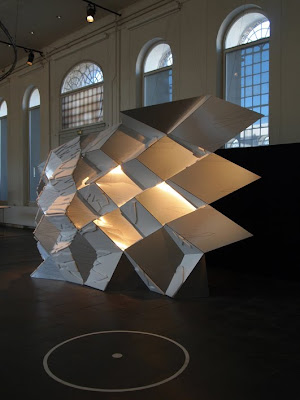

Featuring the thoughts and work of Architects Independent and Independent Architects - respectively Qatar & London based interconnected Architectural & Design R&D Practice(s)...



This cluster aims to develop and evaluate a new generation of parametric tools that embed emergent behavior within parametric models. Swarming, Flocking, Cellular Automata, Genetic Algorithms and Dynamic Relaxation are examples of emergent tools that synthesise data-sets into solutions. In this cluster we will explore sound datascapes in order to investigate how surfaces with variable resonators can be used to reduce particular frequencies of sound in response to shifts within a particular soundscape.
After qualitatively and quantitatively measuring the sound and environmental conditions of selected situations, participants of this cluster will use emergent-parametric tools to search for doubly ruled surfaced forms that accentuate certain frequencies of sound and muffle others. The variable tunable Helmholz resonator is one example of how this can be achieved in association with the design of the surfaces. The emergent nature of our parametric tools allows them to synthesise acoustical analysis by setting up a real-time feedback loop between the data from the parametric model, and the analysis provided by acoustical analysis software: ODEON. The resulting designs will be prototyped at 1:5 using the hot-wire cutter, constraining the geometry to doubly ruled surfaces (the same vocabulary Gaudí used in his later years) and allows for the analysis of the parametric models’ accuracy. The resulting data including acoustic properties, aesthetics, material and manufacturing constraints, is then fed back into the parametric model to improve the next generation of prototypes.

The cluster will be exploring a thoroughly bottom-up approach to construction, by placing ourselves as agents in an emergent system. The goal of the cluster is to demonstrate how ‘invisible’ processes (in this case air and energy flows) generated by the emerging structure can be visualised during the construction process and used to direct the ongoing fabrication process in real time.
Rather than pre-designing a blueprint, the cluster members will be agreeing on rules which will guide the assembly of a physical structure which will mimic some physical and formal characteristics of termite mounds. The role of the computer will be to analyse the emerging structure and simulate alternative rules which can then be applied to the ongoing construction process in order to effect - evolve - the outcome. During development extensive documentation of the rules which guided the construction, how these evolved based on performance feedback and simulations, and the corresponding physical emergence of the structure over time will be recorded and fed back.
Freeform Construction is a multi-disciplinary organisation exploring rapid manufacturing on an architectural scale and its implications for the industry. With an interest in adaptive structures and process integration and with extensive knowledge and expertise of rapid manufacturing, biological processes and innovative construction, they have attracted international media coverage and are collaborating with leading architects. Rupert, Petra and David are among the co-founders of Freeform Construction and together they teach in a diploma studio in architecture at Greenwich University in London which explores digital manufacturing and collaborative workflows.



 Above & below: Examples of some of the display stands on/ around/ across which the textiles were displayed
Above & below: Examples of some of the display stands on/ around/ across which the textiles were displayed
